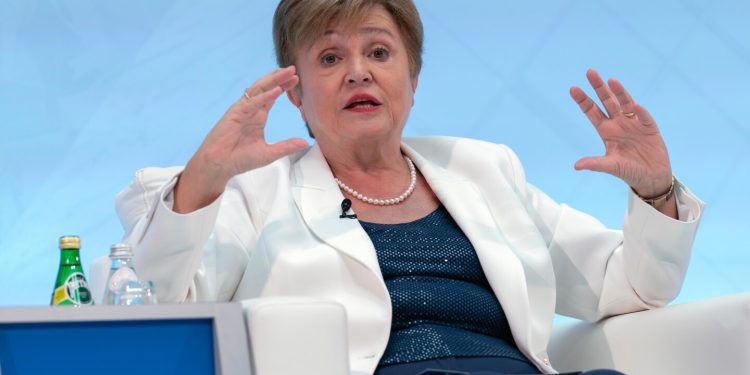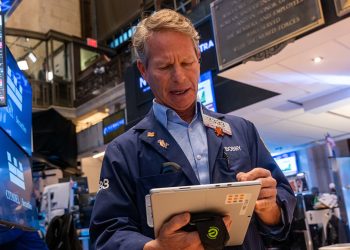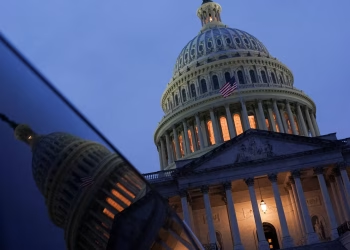WASHINGTON (AP) — The U.S. and global economies will grow somewhat stronger this year than expected as tariffs imposed by the Trump administration have so far proven less disruptive than expected, the International Monetary Fund said Tuesday, although the agency also said the expanded tariffs still pose risks.
United States economy will grow by 2% in 2025, the IMF predicts in its influential biannual forecast, the World Economic Outlook. This is slightly higher than the 1.9% forecast in the IMF report. last updated in July And 1.8% in April. The United States is expected to grow 2.1 percent next year, a tenth of a percent higher than its previous projection, the IMF said.
Its current forecast, however, is still lower than a year ago, a sign that the international credit agency expects the tariffs to weaken the U.S. economy, in part by creating more uncertainty for businesses. Last October, the IMF forecast US growth of 2.2% this year.
All projections also represent a slowdown from 2024, when the U.S. economy grew at a faster 2.8%.
The global economy, meanwhile, will grow 3.2% this year, up from an estimate of 3% in July, according to the IMF forecast, and 3.1% in 2026, like its previous estimate.
Although the U.S. and global economies have performed better than expected, it is too early to say they are completely out of the woods, the IMF said, as Trump has continued to make tariff threats and it may take time for changes in international trade structures to manifest.
On Friday, for example, Trump threatened to slap 100% homework on all imports from China, which caused a sharp fall in the stock market.
IMF chief economist Pierre-Olivier Gourinchas told a news conference that import taxes and persistent threats to impose more duties have created ongoing uncertainty for many businesses and are weighing on the global economy.
“The tariff shock is here, and it further darkens the already weak growth outlook,” he said.
Gourinchas also said that an explosion of investment in artificial intelligence, in the form of huge data centers and expanded computing power, has helped offset the drag on trade and boost the U.S. economy. Still, if a bubble in financial markets formed and then burst, it could sharply slow business investment and consumer spending, he added.
“There are echoes in the current wave of technology investments from the dot-com boom of the late 1990s,” he said. “It was the Internet then, it’s AI now.”
Shares of two companies active in the AI sector, AMD and Oracle, which announced an expanding partnership Tuesdayhave seen their shares rise 80% this year.
Gains in the value of AI-related stocks have increased Americans’ wealth and fueled consumer spending, Gourinchas said, just as companies are ramping up investments in advanced computer chips and building data centers. Increased spending and investment could push central banks to raise interest rates over time, he said.
Gourinchas also discussed several reasons why the U.S. and global economies have remained resilient following the widespread imposition of tariffs earlier this year.
“First and foremost, the tariff shock itself is smaller than initially feared, with many trade agreements and exemptions,” he said. “Most countries have also refrained from any retaliation, thereby keeping the trading system open. And the private sector has also demonstrated agility in fueling upstream imports and rerouting supply chains.”
By concentrating their imports early, many U.S. companies were able to stock up on goods before the tariffs took effect, allowing them to avoid or delay price increases.
Yet many of these factors reflect only “temporary relief, rather than underlying strength in economic fundamentals,” the IMF report said.
The IMF also said that data on U.S. import prices shows that so far, importers and retailers are paying most of the tariffs, not foreign companies, as many Trump administration officials have predicted. Over time, these companies will likely pass on a greater share of price increases to consumers, the report said.
There are signs that some downsides to higher tariffs are starting to emerge, according to the IMF outlook. Core inflation, which excludes the volatile food and energy categories, rose to 2.9%, according to the Federal Reserve’s preferred measure, up from 2.7% a year ago. Hiring is virtually at a standstill, which may in part reflect a more cautious approach by many companies to the uncertainty created by rising tariffs.
The IMF’s forecasts are slightly more optimistic than those of many private sector economists. The National Association for Business Economics, a group of academic and business economists, projected Monday that the United States would grow just 1.8% this year and 1.7% in 2026.
Nearly two-thirds of economists surveyed by NABE believe the administration’s actions are nonetheless slowing growth, by as much as half a percentage point.
China, meanwhile, has resisted the consequences of U.S. tariffs by sending more of its goods to Europe and Asia rather than the United States, the IMF said. Its currency depreciated, making its exports cheaper. The IMF forecasts that China’s economy will grow 4.8% this year and 4.2% in 2026, the same as in July.
Gourinchas said China’s economy has become increasingly dependent on exports, while its real estate sector continues to struggle under heavy debt.
“It is increasingly difficult to see how this could continue,” he added.
In Europe, Germany is supporting growth by increasing public spending to strengthen its military, Gourinchas said. The IMF now expects the 20 countries that use the euro to grow 1.2% this year, up from 1% forecast in July, and 1.1% next year, the same as three months ago.
The IMF is a lending organization of 191 countries that works to promote economic growth and financial stability and to reduce global poverty.









